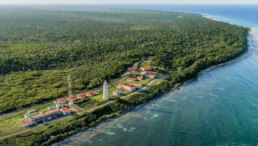Marlin Marina Hemingway - Cuba Sponsors the Ocean Posse
Marlin Marina Hemingway.
5ta Ave y 248, Santa Fe, Playa, Havana, Cuba
+53 5 9883620 whatsaap
reservaciones@prto.mh.tur.cu
nauticamarlin.com
MARINA GAVIOTA CABO SAN ANTONIO CUBA 🇨🇺 SPONSORS THE OCEAN POSSE
Marina Gaviota Cabo San Antonio 🇨🇺 Sponsors the Ocean Posse
21° 54.0783’N 084° 54.4683′ W


AMENITIES
- PORT OF ENTRY POE
- Diesel ( contact to arrange)
- Gasoline ( contact to arrange)
- Water
- Transportation / Taxi
- Rum

SAFE APPROACH
LOCATION
NEARBY
1. Reserva de la Biosfera Península de Guanahacabibes
Declared a UNESCO Biosphere Reserve in 1987, this expansive park features forests, coral reefs, wildlife refuges, and serene beaches—island magic in wild form
2. Playas de Las Tumbas & Playa El Francés Pristine white-sand beaches bordering coastal dunes and reefs, ideal for snorkeling, sunning, and spotting migratory birds along limestone bars in full natural splendor
3. Cueva La Sorda (La Sorda Cave) A myth-haunted sea‑abraded cavern about a legend of two sisters turned serpent and cayman, rich in archaeological remains and local biodiversity including an endemic frog species
4. Morros de Piedra
Rugged limestone formations bordering marshes between beach bars. A scenic habitat for birdlife and unique geological contrasts where reef sands meet coastal scrub
5. Cayos de la Leña (Firewood Cays)
Tiny offshore isles nestled 3–5 miles away; habitats for fishing eagles and local lore connecting them to 16th-century mariners gathering firewood and legend
6. María la Gorda Dive Centre (~within 50 miles, in Guanahacabibes Reserve)
Cuba’s renowned dive resort offering access to ~40 dive sites teeming with black coral, reef systems, and wrecks—ideal for scuba aficionados and marine explorers alike
7. Sistema de Cavernas Santo Tomás / Cueva del Indio
Approximately inland in Sierra de Quemados, it includes the aquatic‑route network from Sierra del Infierno and the Dos Hermanas valley with a Prehistory mural—rich hiking and spelunking grounds
8. Viñales Valley, Las Terrazas & Botanical Treasures
Although inland from Pinar del Río, these UNESCO‑recognized landscapes, orchid gardens (Soroa), waterfalls, tobacco farms, and French‑coffee ruins make for charming excursions into rural western Cuba’s cultural heart
9. The Roncali Lighthouse or Cape San Antonio Lighthouse is a 19th-century Spanish-era lighthouse, still in operation, located at Cape San Antonio, in Sandino, Pinar del Río Province, on the western tip of the island of Cuba.


